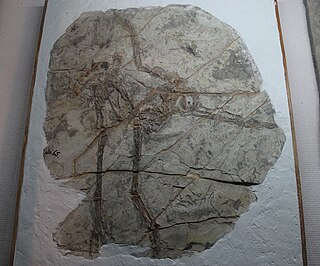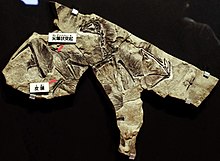
Archaeopteryx, sometimes referred to by its German name, "Urvogel" is a genus of bird-like dinosaurs. The name derives from the ancient Greek ἀρχαῖος (archaīos), meaning "ancient", and πτέρυξ (ptéryx), meaning "feather" or "wing". Between the late 19th century and the early 21st century, Archaeopteryx was generally accepted by palaeontologists and popular reference books as the oldest-known bird. Older potential avialans have since been identified, including Anchiornis, Xiaotingia, and Aurornis.

Protarchaeopteryx is a genus of turkey-sized feathered theropod dinosaur from China. Known from the Jianshangou bed of the Yixian Formation, it lived during the early Aptian age of the Early Cretaceous, approximately 124.6 million years ago. It was probably a herbivore or omnivore, although its hands were very similar to those of small carnivorous dinosaurs. It appears to be one of the most basal members of the Oviraptorosauria, closely related to Incisivosaurus, or a taxon slightly less closely related to birds than oviraptorosaurs were.

Microraptor is a genus of small, four-winged dromaeosaurid dinosaurs. Numerous well-preserved fossil specimens have been recovered from Liaoning, China. They date from the early Cretaceous Jiufotang Formation, 125 to 120 million years ago. Three species have been named, though further study has suggested that all of them represent variation in a single species, which is properly called M. zhaoianus. Cryptovolans, initially described as another four-winged dinosaur, is usually considered to be a synonym of Microraptor.

Maniraptora is a clade of coelurosaurian dinosaurs which includes the birds and the non-avian dinosaurs that were more closely related to them than to Ornithomimus velox. It contains the major subgroups Avialae, Dromaeosauridae, Troodontidae, Oviraptorosauria, and Therizinosauria. Ornitholestes and the Alvarezsauroidea are also often included. Together with the next closest sister group, the Ornithomimosauria, Maniraptora comprises the more inclusive clade Maniraptoriformes. Maniraptorans first appear in the fossil record during the Jurassic Period, and survive today as living birds.

The patagium is a membranous body part that assists an animal in obtaining lift when gliding or flying. The structure is found in extant and extinct groups of flying and gliding animals including bats, birds, some dromaeosaurs, pterosaurs, gliding mammals, some flying lizards, and flying frogs. The patagium that stretches between an animal's hind limbs is called the uropatagium or the interfemoral membrane.

Yixianosaurus is a maniraptoran theropod dinosaur genus from the Early Cretaceous of China.

Scansoriopteryx is a genus of maniraptoran dinosaur. Described from only a single juvenile fossil specimen found in Liaoning, China, Scansoriopteryx is a sparrow-sized animal that shows adaptations in the foot indicating an arboreal (tree-dwelling) lifestyle. It possessed an unusual, elongated third finger which may have supported a membranous wing, much like the related Yi qi. The type specimen of Scansoriopteryx also contains the fossilized impression of feathers.

Scansoriopterygidae is an extinct family of climbing and gliding maniraptoran dinosaurs. Scansoriopterygids are known from five well-preserved fossils, representing four species, unearthed in the Tiaojishan Formation fossil beds of Liaoning and Hebei, China.

Paraves are a widespread group of theropod dinosaurs that originated in the Middle Jurassic period. In addition to the extinct dromaeosaurids, troodontids, anchiornithids, and possibly the scansoriopterygids, the group also contains the avialans, which include diverse extinct taxa as well as the over 10,000 species of living birds. Basal members of Paraves are well known for the possession of an enlarged claw on the second digit of the foot, which was held off the ground when walking in some species. A number of differing scientific interpretations of the relationships between paravian taxa exist. New fossil discoveries and analyses make the classification of Paraves an active subject of research.
Zhongornis is a genus of primitive maniraptoran dinosaurs that lived during the Early Cretaceous. It was found in rocks of the Yixian Formation in Lingyuan City (China), and described by Gao et al. in 2008.

Epidexipteryx is a genus of small paravian dinosaurs, known from one fossil specimen in the collection of the Institute of Vertebrate Paleontology and Paleoanthropology in Beijing. Epidexipteryx represents the earliest known example of ornamental feathers in the fossil record.

Anchiornis is a genus of small, four-winged paravian dinosaurs, with only one known species, the type species Anchiornis huxleyi, named for its similarity to modern birds. The Latin name Anchiornis derives from a Greek word meaning "near bird", and huxleyi refers to Thomas Henry Huxley, a contemporary of Charles Darwin.

Eosinopteryx is an extinct genus of theropod dinosaurs known to the Late Jurassic epoch of China. It contains a single species, Eosinopteryx brevipenna.

Aurornis is an extinct genus of anchiornithid theropod dinosaurs from the Jurassic period of China. The genus Aurornis contains a single known species, Aurornis xui. Aurornis xui may be the most basal ("primitive") avialan dinosaur known to date, and it is one of the earliest avialans found to date. The fossil evidence for the animal pre-dates that of Archaeopteryx lithographica, often considered the earliest bird species, by about 10 million years.

Serikornis is a genus of small, feathered anchiornithid dinosaur from the Upper Jurassic Tiaojishan Formation of Liaoning, China. It is represented by the type species Serikornis sungei.

Anchiornithidae is a family of small paravian dinosaurs. Anchiornithids have been classified at varying positions in the paravian tree, with some scientists classifying them as a distinct family, a basal subfamily of Troodontidae, members of Archaeopterygidae, or an assemblage of dinosaurs that are an evolutionary grade within Avialae or Paraves.

Caihong is a genus of small paravian theropod dinosaur from China that lived during the Late Jurassic period.

Ambopteryx is a genus of scansoriopterygid dinosaur from the Oxfordian stage of the Late Jurassic of China. It is the second dinosaur to be found with both feathers and bat-like membranous wings. Yi, the first such dinosaur, was described in 2015 and is the sister taxon to Ambopteryx. The holotype specimen is thought to be a sub-adult or adult. The specimen is estimated to have had a body length of 32 centimetres (13 in) and a weight of 306 grams (10.8 oz). The genus includes one species, Ambopteryx longibrachium.
Cascocauda is an extinct genus of anurognathid pterosaur from the Late–Middle Jurassic Tiaojishan Formation of Hebei Province, China. The genus contains a single species, C. rong, known from a complete skeleton belonging to a juvenile individual preserved with extensive soft-tissues, including wing membranes and a dense covering of pycnofibres. Some of these pycnofibres appear to be branched, resembling the feathers of maniraptoran theropod dinosaurs, and suggesting that pterosaur pycnofibres may be closely related to feathers in dinosaurs.






























